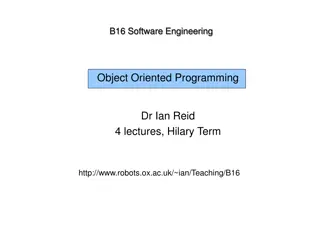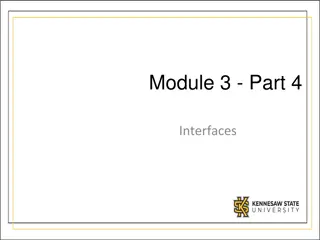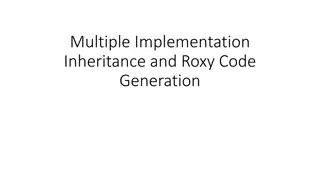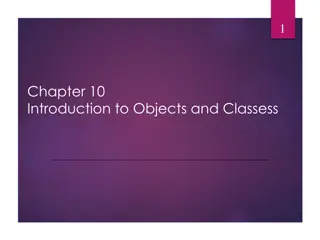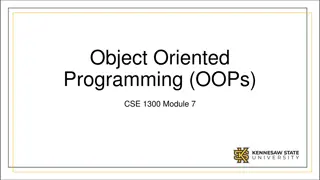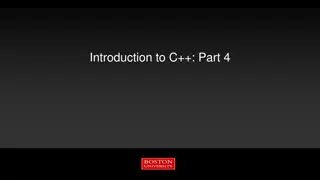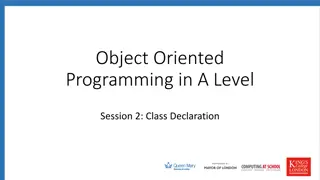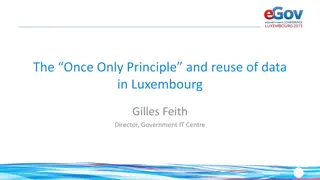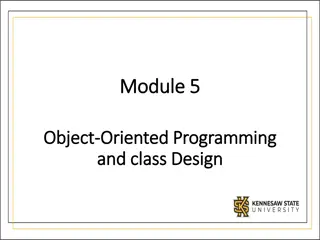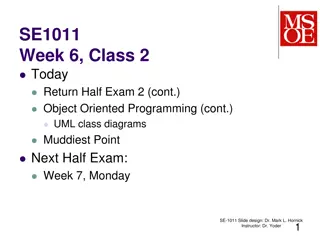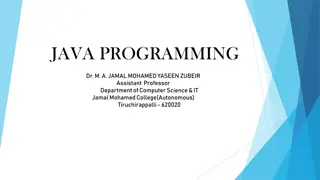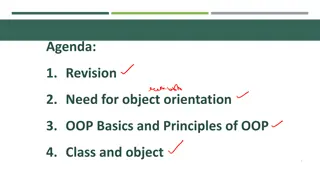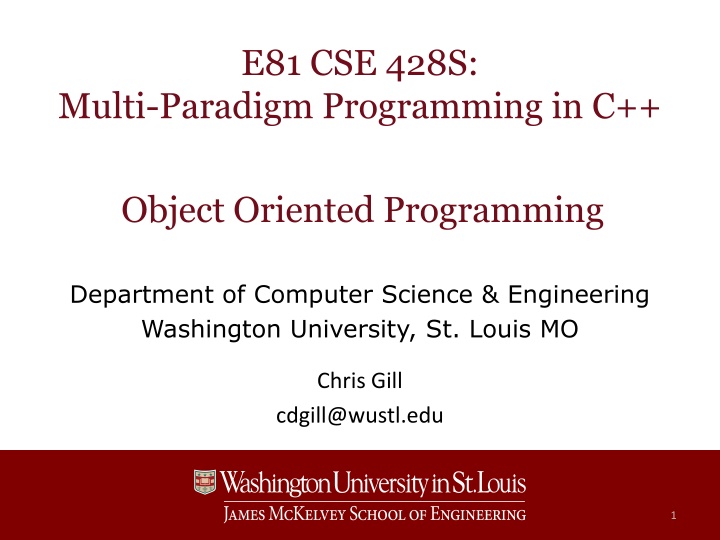
C++ Polymorphism and Inheritance
Dive into the world of C++ polymorphism, exploring user-defined types, inheritance, Liskov Substitution Principle, and the dynamics of static vs. dynamic types. Unravel the complexities of object-oriented programming in C++ with this comprehensive guide.
Download Presentation

Please find below an Image/Link to download the presentation.
The content on the website is provided AS IS for your information and personal use only. It may not be sold, licensed, or shared on other websites without obtaining consent from the author. If you encounter any issues during the download, it is possible that the publisher has removed the file from their server.
You are allowed to download the files provided on this website for personal or commercial use, subject to the condition that they are used lawfully. All files are the property of their respective owners.
The content on the website is provided AS IS for your information and personal use only. It may not be sold, licensed, or shared on other websites without obtaining consent from the author.
E N D
Presentation Transcript
E81 CSE 428S: Multi-Paradigm Programming in C++ Object Oriented Programming Department of Computer Science & Engineering Washington University, St. Louis MO Chris Gill cdgill@wustl.edu 1
Overview of C++ Polymorphism Two kinds of types in C++: user-defined vs. built-in User defined types: declared classes, structs, unions including types provided by the C++ standard libraries Other types are built in to C++ itself: int, long, float, A typedef creates a new type name for another (type aliasing) Public inheritance creates sub-types Inheritance only applies to user-defined classes (and structs) A publicly derived class is-a subtype of its base class Known as inheritance polymorphism Template parameters also induce a subtype relation Known as interface polymorphism We ll cover how this works, in depth, later in the semester Liskov Substitution Principle (applies to both) if S is a subtype of T, wherever you need a T you can use an S CSE 428S Multi-Paradigm Programming in C++ 2
C++ Polymorphism, Continued Inheritance polymorphism depends on public virtual member functions in C++ Base class declares a public member function virtual Derived class overrides the base class definition of it Private or protected inheritance encapsulates May not create a substitutable sub-type A privately derived class wraps its base class The class form of the Adapter Pattern does this CSE 428S Multi-Paradigm Programming in C++ 3
Static vs. Dynamic Type The type of a variable is known statically (at compile time), based on its declaration int i; int * p; Fish f; Mammal m; Fish * fp = &f; Animal Fish Mammal A base class and its derived classes form a set of types type(*ap) {Animal, Fish, typeset(*fp) typeset(*ap) Each type set is open More subclasses can be added However, actual types of objects aliased by references & pointers to base classes vary dynamically (at run- time) Fish f; Mammal m; Animal * ap = &f; ap = &m; Animal & ar = get_animal(); Mammal} CSE 428S Multi-Paradigm Programming in C++ 4
Forms of Inheritance Derived class inherits from base class Public Inheritance ( is a ) Public part of base class remains public Protected part of base class remains protected Protected Inheritance ( contains a ) Public part of base class becomes protected Protected part of base class remains protected Private Inheritance ( contains a ) Public part of base class becomes private Protected part of base class becomes private CSE 428S Multi-Paradigm Programming in C++ 5
Public, Protected, Private Inheritance Class A declares 3 variables i is public to all users of class A j is protected. It can only be used by methods in class A or its derived classes (+ friends) k is private. It can only be used by methods in class A (+ friends) class A { public: int i; protected: int j; private: int k; }; Class B uses public inheritance from A i remains public to all users of class B j remains protected. It can be used by methods in class B or its derived classes Class B : public A { // ... }; Class C : protected A { // ... }; Class D : private A { // ... }; Class C uses protected inheritance from A i becomes protected in C, so the only users of class C that can access i are the methods of class C j remains protected. It can be used by methods in class C or its derived classes Class D uses private inheritance from A i and j become private in D, so only methods of class D can access them. CSE 428S Multi-Paradigm Programming in C++ 6
Class and Member Construction Order In the main function, the B constructor is called on object b Passes in integer values 2 and 3 B constructor calls A constructor passes value 2 to A constructor via base/member initialization list A constructor initializes m_i with the passed value 2 Body of A constructor runs Outputs A B constructor initializes m_j with passed value 3 Body of B constructor runs outputs B class A { public: A(int i) :m_i(i) { cout << "A << endl;} ~A() {cout<<"~A"<<endl;} private: int m_i; }; class B : public A { public: B(int i, int j) : A(i), m_j(j) { cout << B << endl;} ~B() {cout << ~B << endl;} private: int m_j; }; int main (int, char *[]) { B b(2,3); return 0; }; CSE 428S Multi-Paradigm Programming in C++ 7
Class and Member Destruction Order B destructor called on object b in main Body of B destructor runs outputs ~B B destructor calls destructor of m_j int is a built-in type, so it s a no-op B destructor calls A destructor Body of A destructor runs outputs ~A A destructor calls destructor of m_i again a no-op Compare orders of construction and destruction of base, members, body at the level of each class, order of steps is reversed in constructor vs. destructor ctor: base class, members, body dtor: body, members, base class class A { public: A(int i) :m_i(i) { cout << "A << endl;} ~A() {cout<<"~A"<<endl;} private: int m_i; }; class B : public A { public: B(int i, int j) :A(i), m_j(j) { cout << B << endl;} ~B() {cout << ~B << endl;} private: int m_j; }; int main (int, char *[]) { B b(2,3); return 0; }; CSE 428S Multi-Paradigm Programming in C++ 8
Virtual Functions Used to support polymorphism with pointers and references Declared virtual in base class, can override in derived class Signatures must be the same Otherwise that just overloads the function or operator name Ensures derived class function is resolved dynamically E.g., that destructors farther down the hierarchy get called If any other member function is virtual, destructor should be too! Use final (C++11) to prevent overriding of a virtual method Use override (C++11) in derived class to ensure that the signatures match (error if not) class A { public: A () {cout<<" A";} virtual ~A () {cout<<" ~A";} virtual f(int); }; class B : public A { public: B () :A() {cout<<" B";} virtual ~B() {cout<<" ~B";} virtual f(int) override; //C++11 }; int main (int, char *[]) { // prints "A B" A *ap = new B; // prints "~B ~A" : would only // print "~A" if non-virtual delete ap; return 0; }; CSE 428S Multi-Paradigm Programming in C++ 9
Virtual Functions class A { public: void x() {cout<<"A::x";}; virtual void y() {cout<<"A::y";}; }; Only matter with pointer or reference Calls on object itself resolved statically E.g., b.y(); Look first at pointer/reference type If non-virtual there, resolve statically E.g., ap->x(); If virtual there, resolve dynamically E.g., ap->y(); Note that virtual keyword need not be repeated in derived classes But it s good style to do so Caller can force static resolution of a virtual function via scope operator E.g., ap->A::y(); prints A::y class B : public A { public: void x() {cout<<"B::x";}; virtual void y() {cout<<"B::y";}; }; int main () { B b; A *ap = &b; B *bp = &b; b.x (); // prints "B::x" b.y (); // prints "B::y" bp->x (); // prints "B::x" bp->y (); // prints "B::y" ap->x (); // prints "A::x" ap->y (); // prints "B::y" return 0; }; CSE 428S Multi-Paradigm Programming in C++ 10
Potential Problem: Class Slicing Catch derived exception types by reference Also pass derived types by reference Otherwise a temporary variable is created Loses original exception s dynamic type Results in the class slicing problem where only the base class parts and not derived class parts copy CSE 428S Multi-Paradigm Programming in C++ 11
Pure Virtual Functions A is an abstract (base) class Similar to an interface in Java Declares pure virtual functions (=0) May also have non-virtual methods, as well as virtual methods that are not pure virtual class A { public: virtual void x() = 0; virtual void y() = 0; }; class B : public A { public: virtual void x(); }; Derived classes override pure virtual methods B overrides x(), C overrides y() class C : public B { public: virtual void y(); }; Can t instantiate an abstract class class that declares pure virtual functions or inherits ones that are not overridden A and B are abstract, can create a C int main () { A * ap = new C; ap->x (); ap->y (); delete ap; return 0; }; Can still have a pointer or reference to an abstract class type Useful for polymorphism CSE 428S Multi-Paradigm Programming in C++ 12
Design with Pure Virtual Functions Animal move()=0 Pure virtual functions let us specify interfaces appropriately But let us defer implementation decisions until later (subclasses) Fish move() Mammal move() swim() walk() Bird As the type hierarchy is extended, pure virtual functions are replaced By virtual functions that fill in (and may override) the implementation details Key idea: refinement Sparrow move() Penguin move() walk() fly() waddle() swim() CSE 428S Multi-Paradigm Programming in C++ 13
Tips on Inheritance Polymorphism A key tension Push common code and variables up into base classes Make base classes as general as possible Use abstract base classes to declare interfaces Use public inheritance to make sets of polymorphic types Use private or protected inheritance only for encapsulation Inheritance polymorphism depends on dynamic typing Use a base-class pointer (or reference) if you want inheritance polymorphism of the objects pointed to (or referenced) Use virtual member functions for dynamic overriding Even though you don t have to, label each inherited virtual (and pure virtual) method virtual in derived classes Use final (C++11) to prevent overriding Use override (C++11) to make sure signatures match CSE 428S Multi-Paradigm Programming in C++ 14
Studio 8 Declare and define a based class and a class that is derived from it by public inheritance Explore the order of invocation of constructors and destructors in those base and derived classes Examine how virtual vs. non-virtual member functions (and destructors) behave when invoked on objects or via references, pointers, and smart pointer templates Studios 0 through 11 are due 11:59pm Monday October 16th (the night before Exam 0) Submit as soon as each is done so you get feedback and can resubmit any that may be marked incomplete CSE 428S Multi-Paradigm Programming in C++ 15


